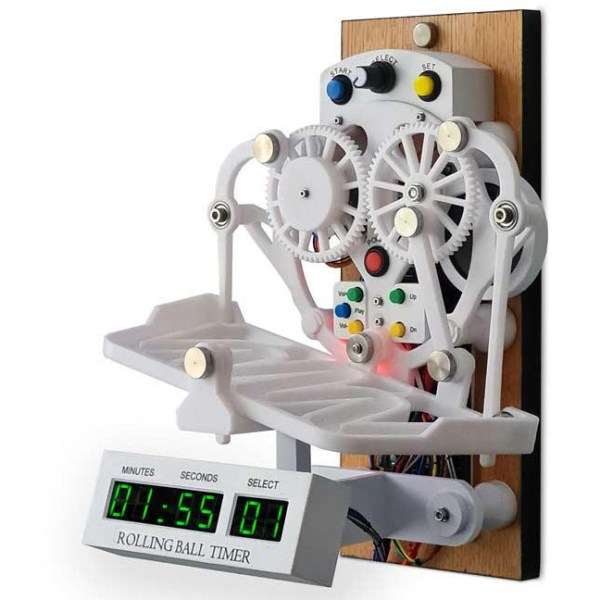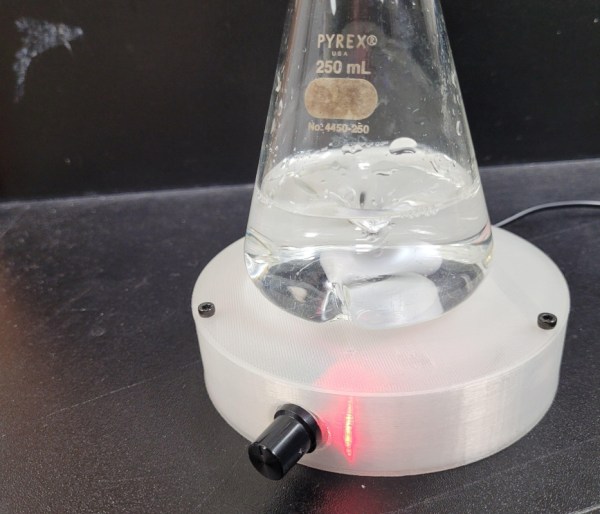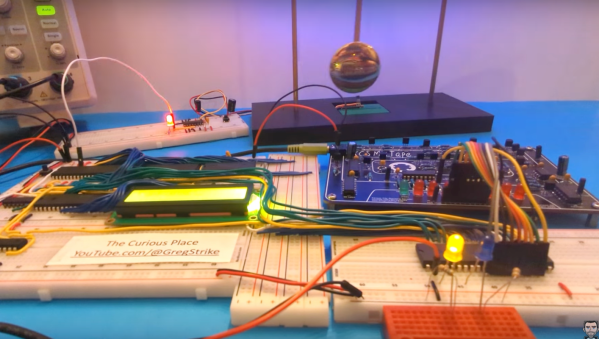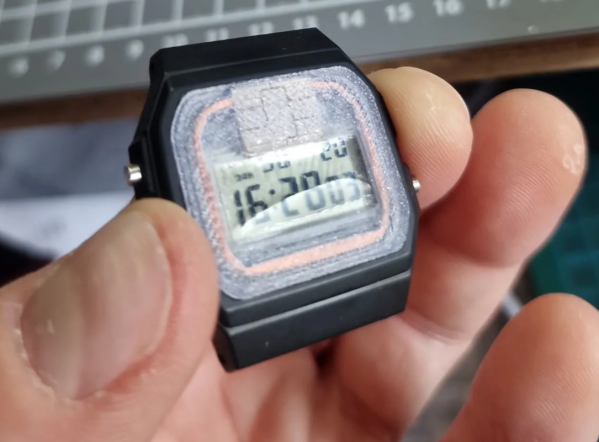Toyota is going through a bit of a Kodak moment right now, being that like the film giant they absolutely blundered the adoption of a revolutionary technology. In Kodak’s case it was the adoption of the digital camera which they nearly completely ignored; Toyota is now becoming similarly infamous for refusing to take part in the electric car boom, instead placing all of their faith in hybrid drivetrains and hydrogen fuel cell technologies. Whether or not Toyota can wake up in time to avoid a complete Kodak-style collapse remains to be seen, but they have been making some amazing claims about battery technology that is at least raising some eyebrows. Continue reading “Toyota Makes Grand Promises On Battery Tech”
Author: Bryan Cockfield1708 Articles
Gas-Powered Fly Swatter Slightly Over-Engineered
Any good flyswatter ought to be able to break through a hefty piece of wood. At least, that is how [Finn] explains the design philosophy behind this enormous, overpowered flyswatter. Although we don’t know if everyone needs as robust a machine as this to deal with a minor annoyance like a house fly, we can certainly appreciate the over-engineered, extremely powerful (and dangerous) machine that can swat flies but also break through a two-by-four with ease.
The build comes to us in two parts, with the first part documenting the construction of some of the parts of the flyswatter, including the piston-driven gas cylinder. As a bit of a tangent, [Finn] first tests this part by using it to shoot lemons at pieces of plywood. After this initial testing of the gas cylinder, a cam mechanism is installed on the top, and the gas cylinder is slightly modified to pull on a piece of Dyneema rope attached to the cam. At the other end of the rope is a long metal lever with the flyswatter on the end, in this case, made out of a sheet of laser-cut plate steel.
With the addition of a few safety features, like a spring-assisted bumper to keep the flyswatter from swinging too far and hitting its operator, the machine is ready for use. It also eventually received some other upgrades as well including extra weights to prevent the flyswatter from bouncing after firing and a reinforced metal rod to hold the flyswatter after its demonstrations on various dimensional lumber destroyed it. In all likelihood, this is the largest insect-control device we’ve seen since this microwave-powered bug zapper. Now if you are building an insect…
Continue reading “Gas-Powered Fly Swatter Slightly Over-Engineered”
Clock Escapement Uses Rolling Balls
The escapement mechanism has been widely used for centuries in mechanical clocks. It is the mechanism by which a clock controls the release of stored energy, allowing it to advance in small, precise intervals. Not all mechanical clocks contain escapements, but it is the most common method for performing this function, usually hidden away in the clock’s internals. To some clockmakers, this is a shame, as the escapement can be an elegant and mesmerizing piece of machinery, so [Brett] brought his rolling ball escapement to the exterior of this custom clock.
The clock functions as a kitchen timer, adjustable in 10-second increments and with several preset times available. The rolling ball takes about five seconds to traverse a slightly inclined, windy path near the base of the clock, and when it reaches one side, the clock inverts the path, and the ball rolls back to its starting place in another five seconds. The original designs for this type of escapement use a weight and string similar to a traditional escapement in a normal clock. However, [Brett] has replaced that with an Arduino-controlled stepper motor. A numerical display at the bottom of the clock and a sound module that plays an alert after the timer expires rounds out the build.
The creation of various types of escapements has fascinated clockmakers for centuries, and with modern technology such as 3D printers and microcontrollers, we get even more off-the-wall designs for this foundational piece of technology like [Brett]’s rolling ball escapement (which can also be seen at this Instructable) or even this traditional escapement that was built using all 3D-printed parts.
Stirring Up 3D-Printed Lab Equipment
Magnetic stirrers are a core part of many chemistry labs. They offer many advantages for ensuring the effective mixing of solutions compared to other methods of stirring, including consistency, precise control, operation within closed systems, and of course, hands-free automatic operation. With so many reasons for employing a magnetic stirrer, it’s not too surprising that [Joey] would want one. He built his using 3D-printed parts rather than purchasing it.
The magnetic stirrer uses a 3D-printed enclosure for the base. Inside is a PWM controller which sends power to a small DC motor. A 3D-printed arm is attached to the motor, which hosts a pair of magnets. As the arm spins inside the enclosure, the magnetic fields from the magnet couple with the stir bar inside the mixture, allowing it to spin without any mechanical link to the stirring device and without any input from the user. [Joey] has also made all the 3D-printed parts for this build available on Printables.
While magnetic stirrers aren’t the most complicated of devices (or the most expensive), building tools like this anyway often has other advantages, such as using parts already on hand, the ability to add in features and customizations that commercial offerings don’t have, or acting as a teaching aid during construction and use. It’s also a great way to put the 3D printer to work, along with this other piece of 3D-printed lab equipment designed for agitating cell cultures instead.
Clock Runs Computer In Slow-Motion
At the heart of all computers is a clock, a dedicated timepiece ensuring that all of the parts of the computer are synchronized and can work together to execute the instructions that the computer receives. Clock speeds for most modern off-the-shelf computers and smartphones operate around a billion cycles per second, and even clocks that tick at a human-dizzying speed of a million times per second have been around since at least the 1970s. But there’s no reason a computer can’t run at a much slower speed, as [Greg] demonstrates in this video where he slows down a 6502 processor to a single clock cycle per second.
To reduce the clock speed from the megahertz range down to a single hertz or single clock cycle per second, [Greg] is using the pendulum from an actual clock. He attaches a small magnet to the bottom of the pendulum which is counted by a sensor as it swings past. Feeding that pulse into a monostable conditioner yields a clock signal which is usable for one of his 6502-based computers, and at this extremely slow rate, it’s possible to see the operation of a lot of the computers’ inner workings a step at a time. In fact, he optimized the computer’s operation as this slow speed let him see some inefficiencies in the program he was running.
It helps if your processor is static, of course. Older CPUs with dynamic storage for registers and some with limited-range PLLs would not work with this technique. The 8080A, for example, required a clock of at least 500 kHz.
Not only can this computer use a pendulum clock as the basis for its internal clock, but [Greg] also rigged up a mechanism to use a heartbeat. Getting in a little bit of exercise to increase his heart rate first will noticeably increase the computer’s speed. And, if you’re looking to get a deeper glimpse into the inner workings of a computer, we’d recommend looking at one which forgoes transistors in favor of relays.
A Controller For More Than Thumbs
As virtual reality continues to make headway into the modern zeitgeist, it is still lacking in a few key ways. There’s not yet an accepted standard for correlating body motion to movement within a game, with most of the mainstream VR offerings sidestepping this problem by requiring the user to operate some sort of handheld controller to navigate the virtual world. And besides a brief Kinect fad from the 2010s, there hasn’t been too much innovation in this area. But computers have continued to increase in capabilities and algorithms for tracking movement have improved, so [Fletcher Heisler] aka [Everything Is Hacked] leveraged these modern tools into a full-body controller configurable for any video game.
This project builds heavily on a previous project by [Fletcher] which took body position information and turned it into keyboard input, leveraging OpenCV and posture detection software to map keys to specific body positions. It only needed slight modification to work for gaming with regards to the ability to hold down keys or mash buttons, but essentially works by mapping certain keystrokes from the previous project to commands in games. In addition to that step he also added support for multiplayer by splitting the image captured by the camera into two halves so it can keep track of two people simultaneously.
Adding Smart Watch Features To Vintage Casio
[Matteo] has been a fan of the Casio F-91W wristwatch virtually since its release in 1989. And not without good reason, either. The watch boasts reliable timekeeping and extremely long battery life thanks to a modern quartz crystal and has just about every feature needed in a watch such as an alarm and a timer. And, since it’s been in use since the 80s, it’s also a device built to last. The only thing that’s really missing from it, at least as far as [Matteo] was concerned, was a contactless payment ability.
Contactless systems use near-field communication (NFC) to remotely power a small chip via a radio antenna when in close proximity. All that’s really required for a system like this is to figure out a way to get a chip and an antenna and to place them inside a new device. [Matteo] scavenges the chip from a payment card, but then builds a new antenna by hand in order to ensure that it fits into the smaller watch face. Using a NanoVNA as an antenna analyzer he is able to recreate the performance of the original antenna setup in the smaller form factor and verify everything works before sealing it all up in a 3D-printed enclosure that sandwiches the watch.
There are a few reasons why using a contactless payment system with a watch like this, instead of relying on a smartwatch, might be preferential. For one, [Matteo] hopes to explore the idea that one of the physical buttons on the watch could be used to physically disable the device to reduce pickpocketing risk if needed. It’s also good to not have to buy the latest high-dollar tech gadget just for conveniences like this too, but we’ve seen in the past that it’s not too hard just to get these systems out of their cards in the first place.

















